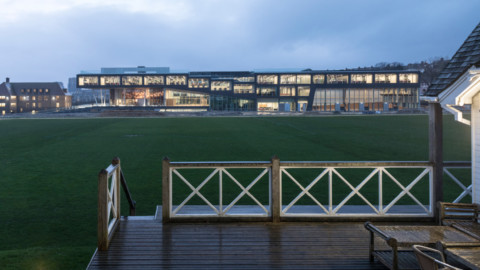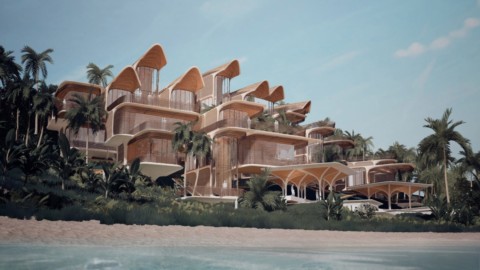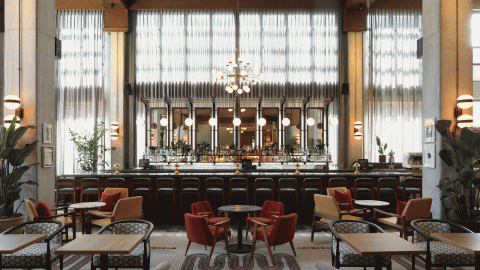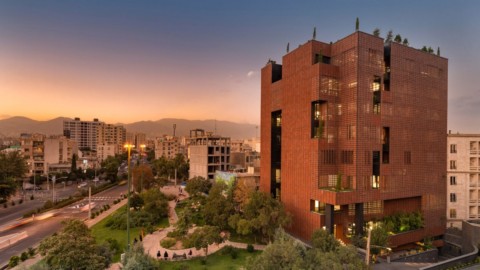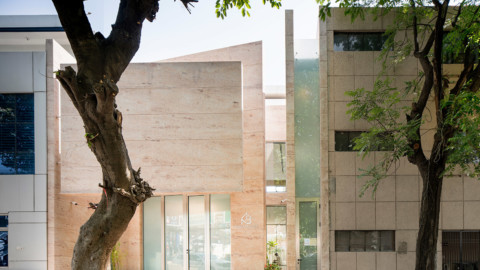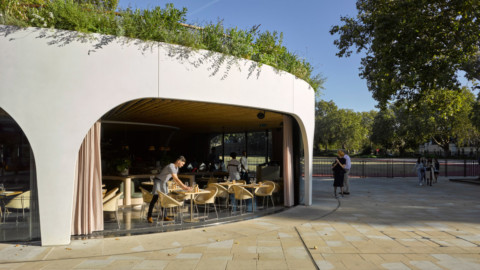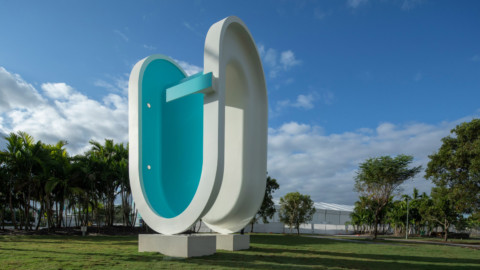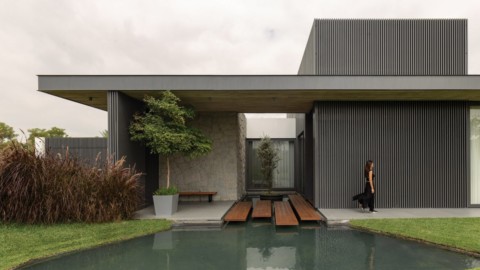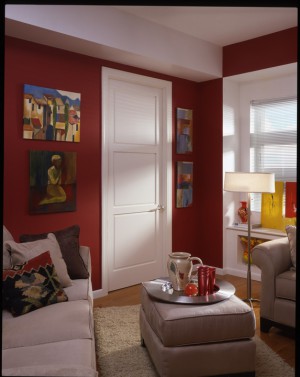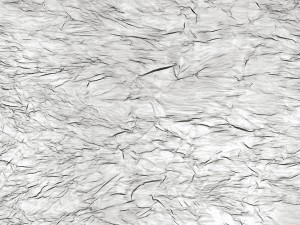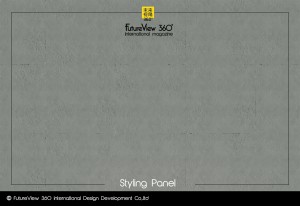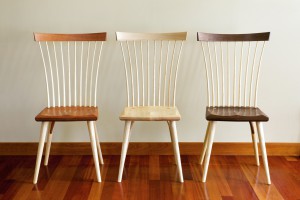Australian studio Austin Maynard Architects has designed a multi-volume, family home in Melbourne that produces its own energy and has a white-shingled facade.
Named Garden House, the home on a narrow residential street in the inner-city suburb of Prahran, Melbourne, replaces an existing single-fronted cottage.
Austin Maynard Architects designed a sustainable four-bedroom family home that is largely hidden from the street and produces an average of 100 kilowatt hours of energy a day.
澳大利亞工作室Austin Maynard Architects在墨爾本設計了一個多容積的家庭住宅,該住宅產生自己的能量並具有白色的帶狀外牆。
名為花園樓(Garden House)的住所位於墨爾本市中心郊區普拉蘭(Prahran)的一條狹窄居民街上,它取代了現有的單面平房。
奧斯汀·梅納德建築師事務所設計了一種可持續發展的四居室家庭住宅,該住宅大部分都位於街道附近,每天平均產生100千瓦時的能源。

“More than just a house, Garden House is a power station, pushing far more sustainable energy back into our shared energy grid than it uses,” said Austin Maynards Architects.
“The home was designed to feel natural and connected to nature with the use of materials, whilst still being hi-tech and high performing.”
奧斯汀·梅納德斯(Austin Maynards)建築師說:“花園屋不僅僅是一座房屋,它還是一個發電站,將更多的可持續能源推回了我們使用的共享能源網格中。”
“房屋的設計旨在感覺自然並通過使用材料與自然聯繫,同時仍保持高科技和高性能。”


The only part of the home visible from the street is a pitched roof garage clad in white shingles that appears to be a modest dwelling.
However, the main home is accessed along a brick passageway beside this garage and is positioned behind the neighbouring homes on the large L-shaped plot.
從街道上只能看到房屋的唯一部分,是一個舖有白色帶狀瓦片的傾斜屋頂車庫,看起來像是一個普通的住宅。
但是,可以通過該車庫旁邊的磚砌通道訪問主房屋,並且該主房屋位於大型L形地塊上相鄰房屋的後面。

“Garden House belies its size and scale,” Austin Maynards Architects. At street-view, the simple and domestic scale garage appears to be the house, in its entirety,” it continued.
“Walk down the side pedestrian alleyway and the main front door opens up to reveal a much bigger property concealed within – like discovering Narnia at the end of a literal yellow brick road.”
奧斯汀·梅納德斯(Austin Maynards)建築師說:“花園住宅掩蓋了它的大小和規模。” 從街道的角度來看,簡單的家用規模的車庫似乎是整個房子。”
“走到人行道旁,主前門打開,露出隱藏在裡面的更大的房產-就像在一條黃磚路的盡頭髮現納尼亞一樣。”

To reduce the scale of the home it was broken up into four blocks “invisibly” connected by mirrored glass corridors to reflect the lush gardens and give the illusion of separate buildings set within the greenery.
The design is a mix of alternating forms. Regular square volumes built from recycled brick and pitched roof volumes clad in white, steel shingles.
為了縮小房屋的規模,將其分為四個部分,通過鏡面玻璃走廊“隱形”地連接起來,以反映鬱鬱蔥蔥的花園,並給人以在綠色植物中設置單獨建築物的錯覺。
設計是多種形式的混合。 用再生磚建造的規則正方形體積,以及舖有白色鋼木瓦的傾斜屋頂體積。

“They didn’t want the feeling of a big house,” the studio explained.
“Instead, the bulk of the home is broken up into four distinct elements appearing as separate buildings, invisibly connected via mirrored glass corridors that reflect the deep-rooted garden.”
製片廠解釋說:“他們不想要大房子的感覺。”
“相反,房屋的大部分被分解為四個不同的元素,表現為獨立的建築物,通過鏡面玻璃走廊無形地連接起來,玻璃走廊反映了根深蒂固的花園。”


The rear of the garage block contains a seating area overlooking the garden with an office above.
In the main house, the largest volume contains a kitchen and dining area attached to an open plan living-dining space that opens up onto the garden and heated pool.
車庫區的後方設有一個休息區,可俯瞰花園,上方設有辦公室。
在主屋中,最大的空間包括一個廚房和用餐區,該廚房和用餐區與開放式起居用餐空間相連,可通向花園和溫水游泳池。


Austin Maynard Architects used natural materials throughout the living spaces, which have glazed walls and bi-fold doors, with the aim of visually extending the garden into the living space.
奧斯汀·梅納德(Austin Maynard)建築師在整個居住空間中使用天然材料,這些材料具有玻璃幕牆和雙折門,目的是在視覺上將花園擴展到居住空間中。


The primary bedroom is located above the living space and has an ensuite and a large lounge terrace.
While the three children’s bedrooms are accessed via a corridor that leads to a separate volume of the building containing play spaces and a TV room.
主臥室位於起居空間上方,並設有套間和寬敞的休息室露台。
通過走廊可以進入三間兒童臥室,走廊通向一個單獨的建築空間,其中包含遊戲空間和電視室。

Although Garden House was designed as a self-powered house the client did not want it to be filled with complex gadgets and technology systems.
It uses an entirely electric power system that is generated from a solar panel array on its roof. The array generates an average of 100 kilowatt hours of electricity per day that is stored within two Tesla Powerwall batteries.
The home contains a 10,000-litre water tank store which is positioned under a concrete slab in the garage, while harvested water collected from rainfall is used to flush the home’s toilets as well as for garden irrigation.
儘管“花園屋”被設計為自供電房屋,但客戶不希望它充滿複雜的配件和技術系統。
它使用由屋頂上的太陽能電池板陣列產生的完全電力系統。 該陣列每天平均產生100千瓦時的電能,存儲在兩個Tesla Powerwall電池中。
該房屋有一個10,000升的儲水箱,位於車庫的混凝土板下,而從雨水中收集來的收集的水則用於沖廁和花園灌溉。

The studio positioned the home on the southern side of the site so that the interior is able to maximise warming potential from the sun.
Glazed walls and concrete floors in the living space help to passively heat the home during the winter months. Its concrete slab will absorb heat from the sun and redistribute it throughout the day.
工作室將房屋定位在場地的南側,以使內部空間能夠最大程度地利用陽光。
起居空間中的玻璃牆和水泥地板有助於在冬季被動加熱房屋。 它的混凝土板將吸收陽光中的熱量並全天重新分佈。


Other homes with an eco-friendly focus include this cabin in Chile that was designed to operate off-grid, this wood-lined holiday home in Tasmania by Maguire + Devlin and this 3.3 metre home in a South African nature reserve that also runs off-grid.
Photography is by Derek Swalwell.
其他注重環保的房屋包括設計用於離網的智利小木屋,馬奎爾+德夫林(Maguire + Devlin)在塔斯馬尼亞島上綠樹成蔭的度假屋以及位於南非自然保護區的3.3米房屋, 網格。
攝影是德里克·斯沃威爾(Derek Swalwell)。
FROM:https://www.dezeen.com/2021/04/06/self-powered-house-austin-maynard-architects-australia/


